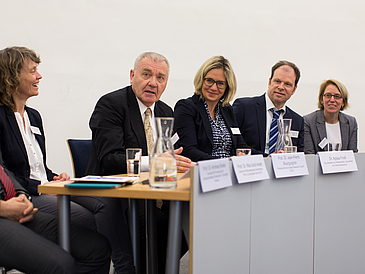Jean-Pierre Bourguignon, President of the European Research Council (ERC), came to the campus at the invitation of Bremen's Senator for Science, Professor Eva Quante-Brandt, to promote European science funding. This European Union contributes significantly to such funding through grants awarded by the European Research Council (ERC). Address his guests, the President of the University of Bremen, Professor Bernd Scholz-Reiter, said: “Over the past ten years, researchers from our University have together with cooperation professorships acquired a total of 17 ERC grants. That translates into 34 million euros.”
“Exchange within Europe”
All told, there were a total of 23 grants in the federal state of Bremen, added Senator Eva Quante-Brandt. As she pointed out, “More important than ever is the exchange within Europe. Scientists play a crucial role in this process. They are always able to talk about their mutual third-party.”
1.8 billion euros in 2017
The following panel discussion with Professor Bourguignon and ERC grantees reviewed the upcoming research framework program, encouraging potential applicants to submit their ideas to the Research Council. In 2017 alone, 1.8 billion euros was channeled into European countries, according to Jean-Pierre Bourguignon, who is a professor of mathematics. “We have good arguments for increasing the budget.” The Synergy Grant for interdisciplinary research is also to be revived. It already existed in 2012 and 2013. New will be a three-stage evaluation. The ERC has budgeted 250 million euros in 2018 for the Synergy Grant.
Personal experiences of the ERC grantees
The Grantees then talked about their personal experiences as applicants. History professor Rebekka von Mallinckrodt (Consolidator Grant 2014) said she was not afraid of a possible refusal. “After all, the work you put into the application is also work on the project,” she said. Professor Kai-Uwe Hinrichs from the MARUM Center for Marine Environmental Sciences, who has already been awarded two Advanced Grants, said, “The biggest thing you can imagine and the utmost you can do in your lab—that's what you have to submit.”

